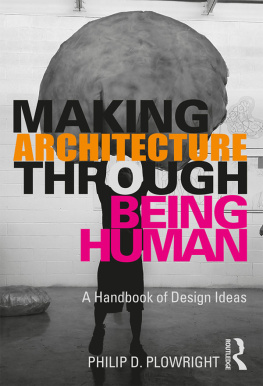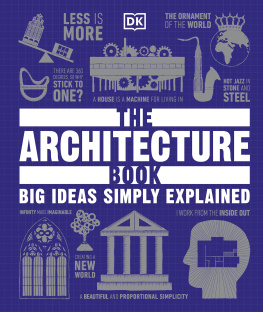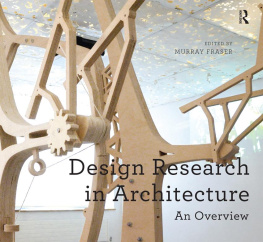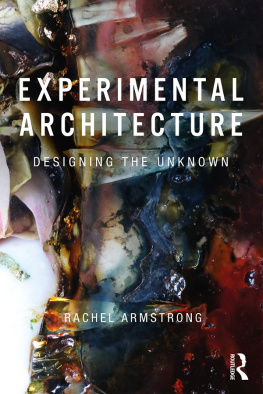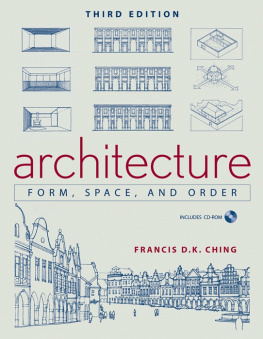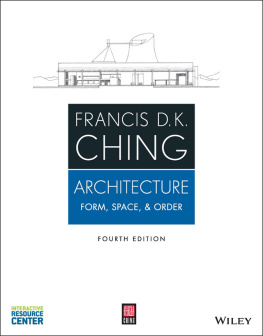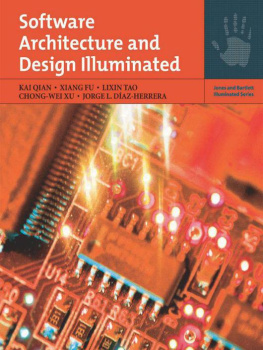Making Architecture Through Being Human
Architecture can seem complicated, mysterious or even ill-defined, especially to a student being introduced to architectural ideas for the first time. One way to approach architecture is simply as the design of human environments. When we consider architecture in this way, there is a good place to start ourselves. Our engagement in our environment has shaped the way we think which we, in turn, use to then shape that environment. It is from this foundation that we produce meaning, make sense of our surroundings, structure relationships and even frame more complex and abstract ideas. This is the start of architectural design.
Making Architecture Through Being Human is a reference book that presents 51 concepts, notions, ideas and actions that are fundamental to human thinking and how we interpret the environment around us. The book focuses on the application of these ideas by architectural designers to produce meaningful spaces that make sense to people. Each idea is isolated for clarity in the manner of a dictionary with short and concise definitions, examples and illustrations. They are organized in five sections of increasing complexity or changing focus. While many of the entries might be familiar to the reader, they are presented here as instances of a larger system of human thinking rather than simply graphic or formal principles. The cognitive approach to these design ideas allows a designer to understand the greater context and application when aligned with their own purpose or intentions.
Philip D. Plowright is Professor of Architectural Design and Theory at Lawrence Technological University, USA. He is an academic researcher, theorist and licenced architect with degrees in studio art, architecture and cognitive linguistics. His interest focuses on developing clarity around foundational knowledge in the applied design disciplines for use in teaching and production environments. His previous book, Revealing Architectural Design (Routledge 2014), addressed the larger thinking frameworks that structure architectural design methods while his research monograph, Qualitative Embodiment in English Architectural Discourse (Universidad de Castilla-La Mancha 2017), looked at latent meaning found between people and environments based on conceptual metaphors and embodied knowledge.
Making Architecture smartly demystifies fundamental thinking about the conceptualization and shaping of architectural form. The illuminating power of naming, cataloging, and cross-referencing 51 primal human ideas sets the stage for early design learning, clarifies a vocabulary of thought and communication, and articulates a basis for coherent design approaches. This is a welcome book and a high value development. Leonard R. Bachman, author of Two Spheres and Constructing the Architect
Students of design will find Philip Plowrights Making Architecture Through Being Human a most potent guide to a rich system of architectural ideas enabling them to grapple with complexity. Hyper-clear diagrams augment evocative descriptions of ideas as potentials instead of rules. Honoring shared, embodied experience as basis for architectural meaning, this elegant and what will prove timeless studio companion belongs on desks of architecture students everywhere. Brook Muller, Dean of the College of Arts + Architecture, University of North Carolina at Charlotte, USA, and author of Ecology and the Architectural Imagination
Making Architecture Through Being Human is a Rosetta Stone of sorts. It explains crucial architectural ideas, concepts, and terminology in an uncomplicated and easy to understand way but this is no mere sourcebook of specifications and standards, nor is it a collection of arcane axioms claiming to convey architectural literacy. The book is the concise, illustrated explanation of terms and ideas that will serve to build a robust foundation for a lifetime of architectural discourse and practice. John Marshall, Associate Professor and Founding Director, MDes Integrative Design, University of Michigan, USA
Philip Plowrights Making Architecture is an excellent introduction to architectural design for students in the early years of their architectural education. The book presents and carefully explains a series of design concepts that students inevitably encounter in studio and it will be a great support in studio teaching both for students and studio tutors. Branko Mitrovic, Norwegian University of Science and Technology, Norway, and author of Philosophy for Architects
MAKING ARCHITECTURE THROUGH BEING HUMAN
A Handbook of Design Ideas
Philip D. Plowright

First published 2020
by Routledge
2 Park Square, Milton Park, Abingdon, Oxon OX14 4RN
and by Routledge
52 Vanderbilt Avenue, New York, NY 10017
Routledge is an imprint of the Taylor & Francis Group, an informa business
2020 Philip D. Plowright
The right of Philip D. Plowright to be identified as author of this work has been asserted by him in accordance with sections 77 and 78 of the Copyright, Designs and Patents Act 1988.
All rights reserved. No part of this book may be reprinted or reproduced or utilised in any form or by any electronic, mechanical, or other means, now known or hereafter invented, including photocopying and recording, or in any information storage or retrieval system, without permission in writing from the publishers.
Trademark notice: Product or corporate names may be trademarks or registered trademarks, and are used only for identification and explanation without intent to infringe.
British Library Cataloguing-in-Publication Data
A catalogue record for this book is available from the British Library
Library of Congress Cataloging-in-Publication Data
Names: Plowright, Philip D., author.
Title: Making architecture through being human : a handbook of design ideas / Philip D. Plowright.
Description: Abingdon, Oxon ; New York, NY : Routledge, 2020.
Identifiers: LCCN 2019039089 (print) | LCCN 2019039090 (ebook) |
ISBN 9780367204761 (hbk) | ISBN 9780367204778 (pbk) |
ISBN 9780429261718 (ebk)
Subjects: LCSH: Architectural design. | ArchitectureHuman factors.
Classification: LCC NA2750 .P585 2020 (print) | LCC NA2750 (ebook) |
DDC 721dc23
LC record available at https://lccn.loc.gov/2019039089
LC ebook record available at https://lccn.loc.gov/2019039090
ISBN: 978-0-367-20476-1 (hbk)
ISBN: 978-0-367-20477-8 (pbk)
ISBN: 978-0-429-26171-8 (ebk)
Typeset in Myriad Pro
by Newgen Publishing UK
TABLE OF CONTENTS
THIS IS A BOOK OF IDEAS that we use to make architecture. Some would restrict architecture to mean the design of a building as a sculptural object, and others might claim all design acts to be architectural from making movies to designing budgets. Still others use the term architecture to refer to the development of software or of foreign policy. In this book, architecture is the practice of designing human environments through the arrangement of form and voids to support human activity with a stress on the human part of that statement. The ideas in the sections that follow are ones that people use to make sense of the spaces they inhabit how we make a human environment meaningful for humans. These ideas are very basic but important because they form the foundation of more complex arrangements and intentions. As such, the point of view of the book is based on how we think, how we prioritize ideas, and how those ideas take physical shape in our world.

